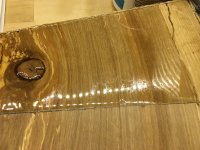ear3
Member
I'm using the cut-offs from my spalted maple slab conference table project (http://festoolownersgroup.com/member-projects/bookmatched-spalted-maple-conference-table-build/) to make a smaller coffee/end table, and I ran into some issues with sanding that I've never encountered before. I noticed these issues when doing the conference table as well, but didn't think much about it at the time -- but now that it's happened again I know it was not just my imagination.
With the size panel created by the offcuts, I should normally be able to do both sides with a single sheet of Granat abrasive. But I found as I stepped up the grits that the life span of the sheets became progressively shorter (mounted on ETS-EC 150/5 with DC). At 180 it was only one sheet per side, and by the time I topped out at 400 it was almost 3 sheets per side. The abrasive would quickly stop cutting the surface and instead just burnish it. I feel like the abrasive life span might have improved slightly after I started vacuuming and wiping with a cloth between grits, which I normally don't do at the lower grits, but that might have just been my wishful thinking.
The only thing I can think of is that there's something about the epoxy resin I used to fill the cracks and holes (West System 105 + 205 and 207) that takes a toll on the abrasive. The epoxy is certainly fully cured, as I did it last weekend. I examined the paper and there was no visible loading up or clogging. I didn't do any experiments with changing speed of the sander. I would note though that when sanding with the RS2 (which has a smaller/finer orbit), which I used up to 150 to keep the plank flat, I did not seem to have any problems.
Any thoughts?
With the size panel created by the offcuts, I should normally be able to do both sides with a single sheet of Granat abrasive. But I found as I stepped up the grits that the life span of the sheets became progressively shorter (mounted on ETS-EC 150/5 with DC). At 180 it was only one sheet per side, and by the time I topped out at 400 it was almost 3 sheets per side. The abrasive would quickly stop cutting the surface and instead just burnish it. I feel like the abrasive life span might have improved slightly after I started vacuuming and wiping with a cloth between grits, which I normally don't do at the lower grits, but that might have just been my wishful thinking.
The only thing I can think of is that there's something about the epoxy resin I used to fill the cracks and holes (West System 105 + 205 and 207) that takes a toll on the abrasive. The epoxy is certainly fully cured, as I did it last weekend. I examined the paper and there was no visible loading up or clogging. I didn't do any experiments with changing speed of the sander. I would note though that when sanding with the RS2 (which has a smaller/finer orbit), which I used up to 150 to keep the plank flat, I did not seem to have any problems.
Any thoughts?




